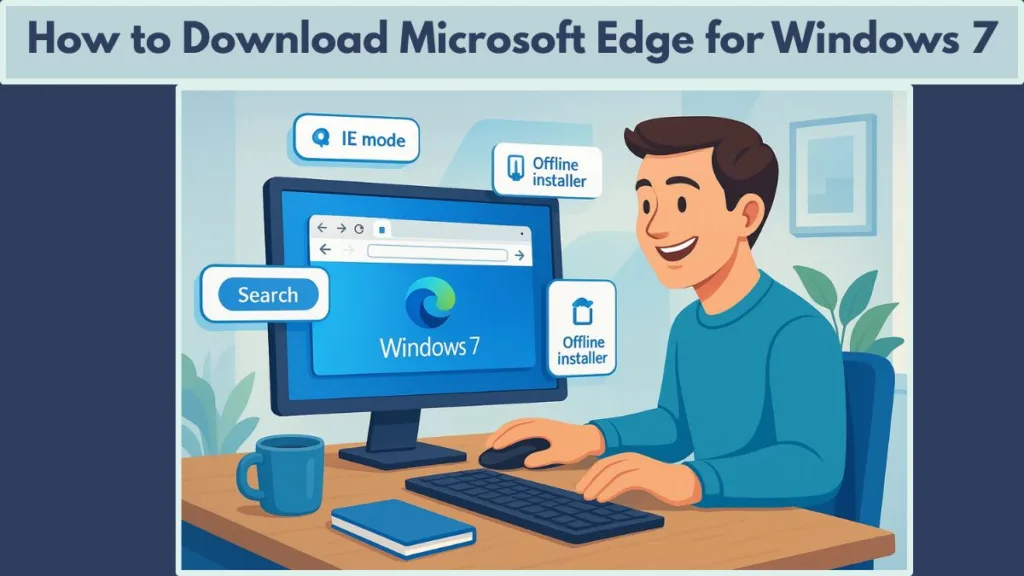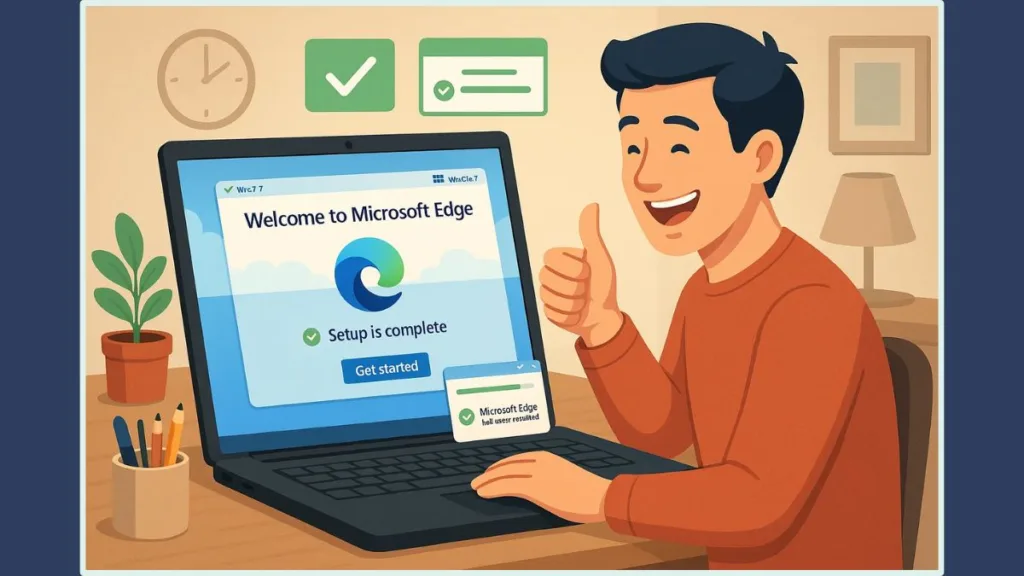Do you want to download Microsoft Edge for Windows 7 in 2025? Discover how to safely download and install Edge using the official offline installer.
Follow our step-by-step guide to enjoy modern browsing, IE Mode compatibility, and enhanced performance on your Windows 7 PC without needing an internet connection during setup.
Even though Microsoft officially ended support for Windows 7 in January 2020, this operating system is still widely used in homes, schools, and businesses. Many users rely on it for legacy applications, older hardware compatibility, or organizational IT requirements. However, browsing the web safely on Windows 7 requires a modern, secure, and reliable browser — that’s where Microsoft Edge for Windows 7 comes in.

Built on the powerful Chromium engine, Edge delivers a modern browsing experience, comparable to Google Chrome, while including Microsoft-specific enhancements. Features like IE Mode for legacy applications, better performance, and security improvements make Edge a practical choice for Windows 7 users.
Is Microsoft Edge Still Supported on Windows 7?
Although Edge can still be installed and used on Windows 7, official support ended with version 109. After this version, Microsoft no longer provides security updates or feature improvements, which means users must be cautious when using Edge on Windows 7.
Key points about Edge on Windows 7:
- Compatible with Windows 7 SP1 with the required updates.
- Supports IE Mode, enabling access to legacy web applications.
- No longer receives updates past version 109.
- Limited synchronization with Microsoft accounts.
Despite these limitations, Edge 109 remains a stable and functional browser for daily browsing, streaming, and internal corporate tools.
Why Choose Microsoft Edge on Windows 7 in 2025?
Even with the end of support, Edge offers several advantages over older browsers like Internet Explorer:
Modern Performance for Legacy Systems
Edge uses the Blink rendering engine, delivering faster performance and better resource management compared to Internet Explorer. This makes it ideal for older PCs with limited processing power or RAM.
Internet Explorer (IE) Mode for Legacy Applications
Edge includes IE Mode, allowing users to access older websites and intranet portals built for Internet Explorer. This feature is particularly useful for businesses that rely on legacy web applications.
Enhanced Security Compared to Internet Explorer
Even without ongoing updates, Edge provides better sandboxing, anti-tracking tools, and adherence to modern web standards. This reduces crashes, improves site rendering, and offers a safer browsing experience than IE.
Familiar Microsoft Ecosystem
Edge integrates with Microsoft services, bookmarks, and extensions, making it easier for users transitioning from Internet Explorer or other Microsoft products.
System Requirements for Microsoft Edge on Windows 7
Before installing Edge, ensure your system meets the following minimum requirements:
| Component | Requirement |
|---|---|
| Operating System | Windows 7 SP1 with KB4474419 and KB4490628 updates |
| Processor | 1 GHz or faster with SSE2 support |
| Memory | 2 GB RAM (32-bit) / 4 GB RAM (64-bit) |
| Disk Space | Approximately 300 MB for installation |
| Internet | Required for web installer; optional for offline installer |
Installing the latest service packs and updates ensures a smoother installation process and minimizes compatibility issues.
How to Download Microsoft Edge for Windows 7 (Offline Installer)
Users have the choice between the web installer and the offline installer.
- The web installer is small but requires an active internet connection during installation.
- The offline installer contains all setup files, allowing installation on multiple systems without internet connectivity, making it ideal for businesses or multiple PCs.
Step-by-step guide to download Edge offline:
- Visit the official Microsoft Edge for Business portal:
Microsoft Edge Business Download Page - Under “Select Channel/Version,” choose Stable (recommended).
- Under “Select Platform,” select Windows 7.
- Choose your system architecture: 32-bit, 64-bit, or ARM64.
- Click “Download”, then “Accept and Download” to start the download process.
The offline installer file sizes are:
- 64-bit: 176 MB
- 32-bit: 157 MB
This ensures that the setup can be installed even on systems without a reliable internet connection.

How to Install Microsoft Edge on Windows 7 Using Offline Installer
After downloading the offline installer:
- Navigate to your Downloads folder.
- Right-click the EdgeSetup.msi file and select Run as Administrator.
- Follow the on-screen instructions to complete installation.
- Launch Edge and select your preferred theme: Focused, Inspirational, or Informational.
Using the offline installer minimizes errors related to connectivity or unsupported web installer issues.
Common Installation Issues and Solutions
- Installation Failed: Ensure that KB4474419 and KB4490628 updates are installed.
- Unsupported OS Error: Confirm that Windows 7 SP1 is installed.
- DLL Missing Error: Install the latest Microsoft Visual C++ Redistributable packages.
The offline installer is the most reliable method for installing Edge on Windows 7, especially in enterprise environments or restricted networks.
Using Microsoft Edge After End of Support
Using Microsoft Edge After Support Ended
Even without updates, Edge 109 continues to perform well for general web activities. Users can:
- Browse websites, watch videos, and stream content.
- Access legacy intranet and web apps via IE Mode.
- Install compatible Chromium extensions.
However, Edge no longer receives security updates, and features like account sync may be limited. Users performing sensitive activities should be cautious and consider upgrading to Windows 10 or 11.
Microsoft Edge vs Other Browsers for Windows 7
| Feature | Edge 109 | Chrome 109 | Firefox ESR | Brave |
|---|---|---|---|---|
| Speed | Fast | Fast | Moderate | Fast |
| IE Mode | Supported | Not available | Not available | Not available |
| Security Updates | Ended | Ended | Active | Active |
| Offline Installer | Available | Available | Available | Available |
Edge is ideal for legacy compatibility, while browsers like Firefox ESR or Brave are better for ongoing security updates.
Security Tips for Windows 7 Users Running Edge
To stay secure while using Edge on Windows 7:
- Use reliable antivirus software.
- Avoid entering sensitive personal data on untrusted websites.
- Keep the firewall enabled.
- Enable HTTPS-only mode in Edge.
- Consider upgrading to Windows 10 or 11 for long-term safety.
Taking these precautions ensures a safer browsing experience despite using an unsupported OS.
Frequently Asked Questions (FAQs)
Q1. Is there an offline installer for Microsoft Edge for Windows 7?
Yes. Microsoft offers official offline MSI installers for 32-bit, 64-bit, and ARM64 systems.
Q2. How do I install Edge on Windows 7 without an internet connection?
Download the MSI file from the Microsoft Edge Business page and run it offline — no internet required during installation.
Q3. Does Microsoft Edge still get updates on Windows 7?
No. Edge 109 is the final version for Windows 7, released in 2023.
Q4. What’s the difference between the Edge web installer and offline installer?
The web installer downloads setup files during installation, whereas the offline installer contains all necessary files in a single package.
Q5. Is Microsoft Edge safe to use on Windows 7?
For basic browsing, yes. However, Windows 7 no longer receives updates, so extra security measures or an OS upgrade is recommended.
Final Thoughts
Even with the end of official support, Microsoft Edge 109 brings a modern browsing experience to Windows 7. The offline installer ensures hassle-free installation on multiple systems, while IE Mode keeps older applications accessible.
For users who rely on Windows 7, Edge offers the best combination of compatibility, speed, and stability. However, always remember that security is critical — consider upgrading your OS for a safer and more future-proof browsing experience.
In summary: Microsoft Edge for Windows 7 provides a reliable and functional browsing solution in 2025, keeping legacy systems usable while bridging the gap to modern web standards.
Visit Our Post Page: Blog page
